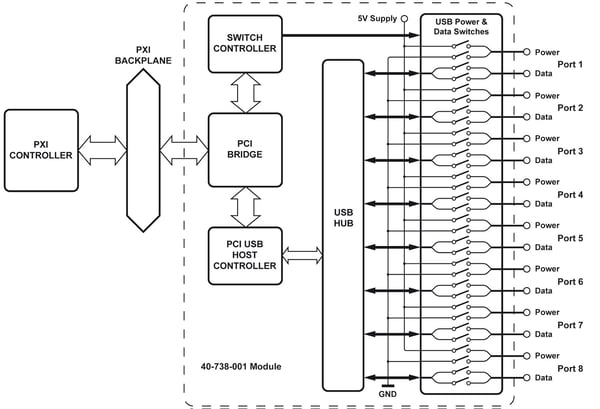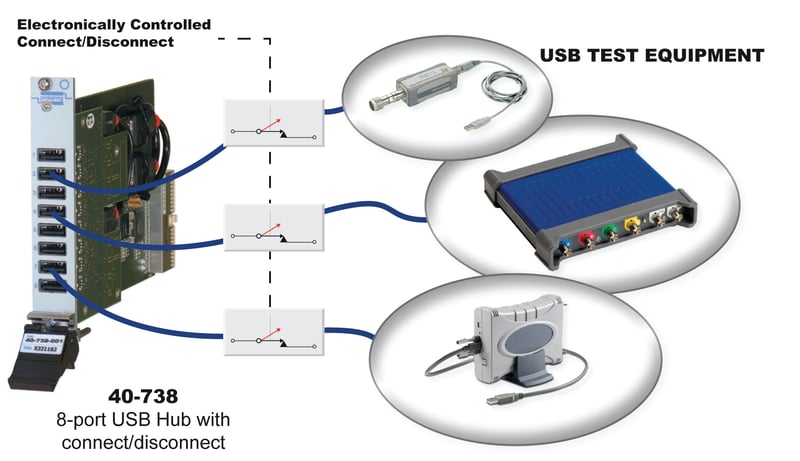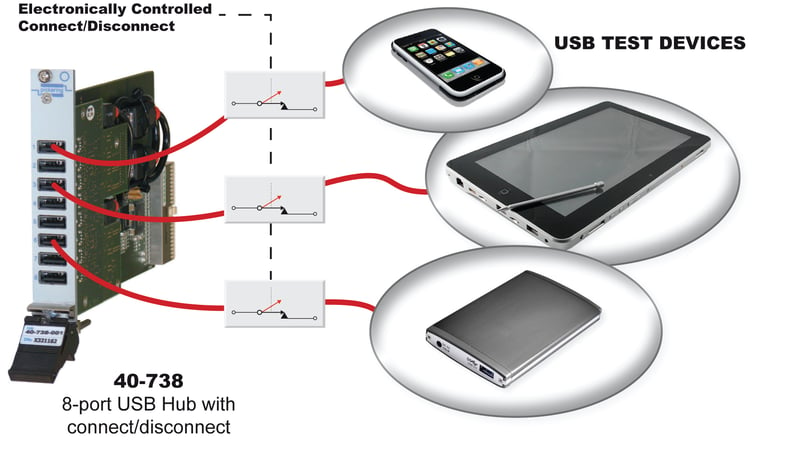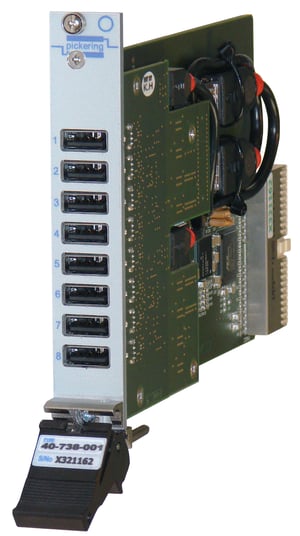How to Introduce USB into a PXI Test Environment
Much has been said about integrating PXI products with LXI and VXI to create hybrid test systems, taking the best of each standard and combining it with the premier standard for modular instrumentation. Pickering Interfaces has undoubtedly seen many synergies between PXI and LXI for switching applications. LXI offers better solutions for large switching systems with high performance, and PXI offers better solutions for smaller and more diverse switching systems.
However, very little has been said about combining PXI and USB products in a test system— yet USB is a prevalent interface on consumer and professional products and ubiquitous on many mobile devices. Hence, a test system ideally needs the capability of supporting USB.
Benefits of USB
The USB standard has also been used in creating elegant and cost-effective solutions in test. For example, USB-based RF power meters are available from several vendors, while others have created data acquisition systems and even basic scopes and DMM's. These instruments often benefit from being supported by USB power alone, avoiding the need for AC power sources, resulting in modest power requirements and size.
They can also typically be placed more directly on a connection to be measured. For example, a power meter sensor will be positioned at the RF connector rather than be fixed in a chassis. USB devices can be placed closer to the measurement point than devices that are chassis-mounted as long as they are within reach of 5 meters of the system controller. That means that USB devices can bring a different set of features to a test system, and as with LXI, there are advantages in adding USB to a system with PXI content.
A USB device can be added to a test system using the USB ports on the system controller. If the system controller is external to the chassis, the USB devices are not part of the chassis system. If the PXI embedded controller is used, chances are it has a limited number of USB ports because of the limited panel space, so it requires a separate USB hub and another AC power connection to power it. That is not always convenient.
When a device is tested, it may not be wise to connect a test device directly to an expensive PXI controller - whether embedded in the chassis or remotely connected. This is because devices to be tested are expected to have faults, or there would be no need to test them, and some of those faults could prove damaging to the controller.
An Innovative Solution
One solution you might consider for integrating USB with your PXI test environment is a module similar to our PXI 8-port USB Hub with connect/disconnect. This module provides a USB switch that allows a single USB connection to be switched to one of eight USB devices, allowing a test system to programmatically select one out of several USB devices to connect into the USB common. However, it does not allow simultaneous connection to all the USB outputs—that requires a USB hub since it simply provides a means of connecting a USB "common" to one of eight USB output connections through a mechanical relay-based switch. The 40-738 PXI USB Hub or the 42-738A PXIe USB Hub seeks to change that and adds the ability to attach USB test devices and USB test equipment directly to a PXI or PXIe chassis.
Click here to learn more about the 40-738 PXI USB Hub
How the 40-738 USB Hub Works
The 40-738 and 42-738A are single-slot 3U PXI modules that combine an eight-port USB 2.0 hub and USB data/power switching to provide a controlled connection between the PXI controller's PCI/PCIe interface (the PXI/PXIe backplane) and USB products. The 40-738 connects to the PCI backplane of the PXI chassis, and the 42-738A connects to the PCIe backplane of the PXIe chassis, rather than a USB port on the controller. It's connected via the chassis PCI/PCIe bus to the controller's internal PCI/PCIe bus in the same way as other PXI and PXIe modules are. The hub appears on the controller's device list the same way as any other USB hub would, but the 40-738 and 42-738A are fully integrated into the chassis.
USB products connected to the 40-738 and 42-738A initiate the same driver install procedures familiar to all USB users when first connected. The PXI/PXIe controller, remote or embedded, recognizes the USB device and installs the vendor's drivers as though the product was connected to the controller's native USB ports. The process is entirely familiar to all PC users, and it requires no software support from Pickering Interfaces.

The 40-738 USB hub allows a USB connection to one or more USB outputs to be made from the PCI bus of the PXI system controller
As well as providing a programmatically managed USB connection, the 40-738/42-738A eliminates the need for free-standing powered hubs in a system—it creates a system where USB connectivity is provided through the chassis rather than separate USB hubs. This method also assures users that the connected USB device on a physical port is released at the time of disconnect.
For purposes of Fault Insertion testing, the 40-738/42-738A features programmatically controlled relays on all power and data lines, allowing the test program to simulate a bad USB cable.
Summary
In addition to aiding the testing of USB products, the 40-738 allows the addition of USB instrumentation to be added to PXI - such as power meters, scopes, and data acquisition products, expanding the range and types of test products that can be supported. In some cases, this adds new instrumentation capabilities such as power meters. In other cases, it adds the possibility of integrating products such as low-cost USB data acquisition wired directly into the chassis instead of into the controller.
The 40-738 and 42-738A USB Hub simplifies integrating USB devices and test equipment into the PXI test environment and represents a significant expansion of user choice for adopters of PXI test solutions.


Want to learn more about USB solutions for a PXI test environment? Check out our Support Knowledgebasee.

